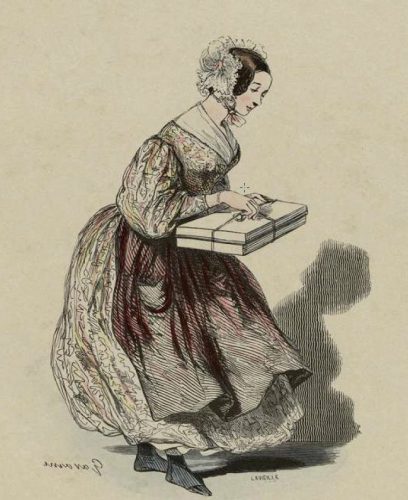
I have recently come across a new-to-me description of a type of woman common in Parisian culture of the late 16th through 19th centuries. I thought this was rather interesting so thought I’d share. I’m sure that others know more about this subject, but from my very short acquaintance, here is the information I have found about the grisette.
The “Grisette” is usually woman between sixteen and thirty. The “Gris” part of her title is the French for gray, and refers to the gray cheap fabric that girls of lower working class often wore. She was described as working all week and having fun on Sundays, and her attire was often set apart by a whimsical but cheap little hat or other some such accessories. She was a woman of the lower working classes- often working in fashion in the dressmaking and millinery trades as a shop assistant.
Millinery and dressmaking were often seasonal work- leaving many people without pay for months at a time (source). Unfortunately in the 19th century, several of the lower incomes were forced into questionable part time work- such as prostitution, in order to make ends meet. That resulted in the term “grisette” morphing sometime in the 19th century from an honest (but sometimes flirtatious) young girl who works in dressmaking and millinery trades to a worker in those trades who had questionable sexual morality.
Of course, literature and art would have us have a much more romanticized version of what the grisette really was like. Almost always beautiful, devoted, but promiscuous, they were portrayed as lovers of artists or musicians, or of college students. But the reality was often different, as it so often is. In literature and art she was sometimes tied up in bohemian subcultures and worked as an artist’s model, or became a lover of types of men in those circles, or the playmate of young college students.
Mark Twain, as a foreigner who was only acquainted with the grisette through art or literature, writes the following in Chapter XV of Innocents Abroad (1869)
“Ah, the grisettes! I had almost forgotten. They are another romantic fraud. They were (if you let the books of travel tell it) always so beautiful—so neat and trim, so graceful—so naive and trusting—so gentle, so winning—so faithful to their shop duties, so irresistible to buyers in their prattling importunity—so devoted to their poverty-stricken students of the Latin Quarter—so lighthearted and happy on their Sunday picnics in the suburbs—and oh, so charmingly, so delightfully immoral!
Stuff! For three or four days I was constantly saying:
“Quick, Ferguson! Is that a grisette?”
And he always said, “No.”
He comprehended at last that I wanted to see a grisette. Then he showed me dozens of them. They were like nearly all the Frenchwomen I ever saw—homely. They had large hands, large feet, large mouths; they had pug noses as a general thing, and moustaches that not even good breeding could overlook; they combed their hair straight back without parting; they were ill-shaped, they were not winning, they were not graceful; I knew by their looks that they ate garlic and onions; and lastly and finally, to my thinking it would be base flattery to call them immoral.
Aroint thee, wench! I sorrow for the vagabond student of the Latin Quarter now, even more than formerly I envied him. Thus topples to earth another idol of my infancy.”
In the end, despite all the romanticism about her and her lovers, the grisette usually married within her class. Jules Janin says
“Thus, she passes from an amorous poet to a brutal husband, from laughter to tears, from merry poverty to harsh indigence. All is finished for her… She does not die, luckily, without leaving a good provision for grisettes to succeed her.”
The mentions of her are often romantic for the era, or maybe even risque, but I can’t help feel a bit sorry for the grisette and the hard circumstances of being a working class woman in poverty in the 19th century.
If you know more about the grisette, please share your knowledge in the comments below.
References-
Wikipedia- Grisette (person)
Louis Octave Uzanne, The Modern Parisienne, 1912, pg 83-85.
Jules Janin, “The Grisette” (source)
Valerie Steele, Paris Fashion, 1988, pg 70-75.

Helen Mae
October 9, 2016 at 12:52 am (8 years ago)That was really interesting, and not something I’ve come across before. Thanks for sharing :)
Piper Springs
October 9, 2016 at 9:02 am (8 years ago)I would add that the name grisette referred not only to a common color of clothing, but also a state of in between morality; neither black nor white, and additionally implied a drab state of life. Twain’s comments on the grisettes at first glance seem insulting as they are based in evaluating a woman’s worth on her appearance; however with further consideration, one realizes that he is giving his youthful narrator exactly what he deserves for objectifying women, a dose of reality. Gotta love Twain.
One would hope that human rights has progressed far enough to empower women to break both gender and social class stereotypes, and eliminate the grisettes, and yet a form of this type of woman (or man) continues to persist….think Nine to Five; Sex in the City. Interesting topic.
costumekullan
October 9, 2016 at 12:03 pm (8 years ago)Fantine in Les Miserables is a typical example of a grisette, and even if it’s been some time since I read the novel I’m pretty sure that she’s mentioned as such in it.